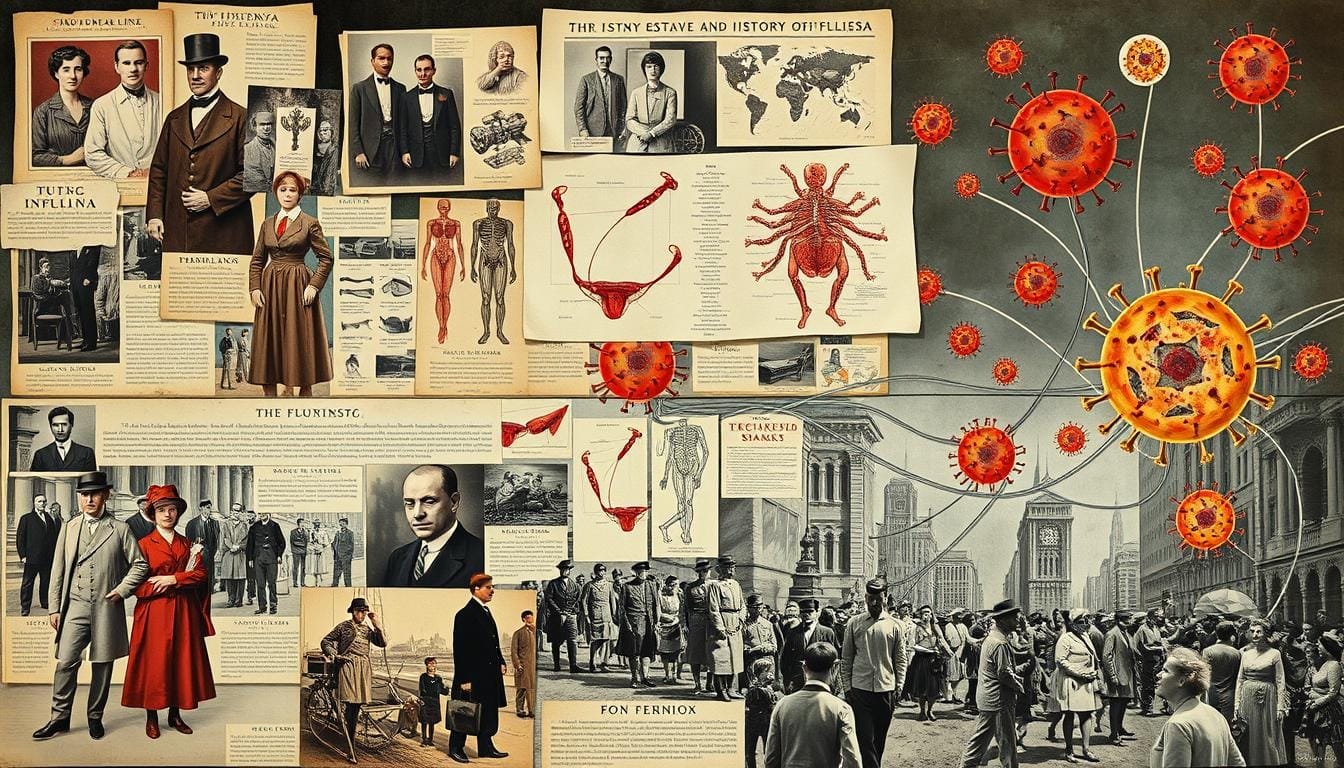The flu, or influenza, has always been a big part of our global health history. Many researchers and medical experts find the history of the flu very interesting. This is because it has had a big impact on society through the years. One of the biggest flu events was the Spanish flu pandemic in 1918. It caused between 21 million to 50 million deaths all over the world.
In just the United States, 675,000 people died from the virus. This number was higher than the death tolls from several wars put together. This shows us how serious influenza can be and why it grabs the attention of so many people.
Many believe that the 1918 Spanish flu started in Fort Riley, Kansas. The first case was reported on March 11, 1918. This flu spread quickly and killed a lot of people, making it a turning point in our history of fighting pandemics. Nurses were especially important during this time.
They had to deal with a huge number of flu cases and not enough medical supplies. This really showed how critical healthcare workers are in times of crisis.
Key Takeaways
- The 1918 Spanish flu pandemic resulted in an estimated 21 million to 50 million deaths worldwide.
- One of the first recorded cases was at Fort Riley, Kansas, on March 11, 1918.
- The U.S. lost 675,000 people to the Spanish flu in 1918.
- Nurses were crucial during the Spanish flu pandemic, facing overwhelming cases and medical shortages.
- Understanding flu history and influenza origins helps in preparing for future pandemics.
The Early History of Influenza
The history of influenza spans centuries, showing humans have battled respiratory illnesses for a long time. Ancient texts describe diseases similar to flu, dating back to Hippocrates around 400 BCE. These descriptions help us see how ancient people faced respiratory outbreaks, underscoring the flu’s long history.
Ancient Descriptions of Respiratory Illnesses
Many old records talk about severe respiratory diseases before we used the word ‘influenza.’ Hippocrates, called the “Father of Medicine,” wrote about symptoms that look a lot like today’s flu. This tells us people knew about flu-like illnesses thousands of years ago. By the 1500s, flu outbreaks were recorded all over the world. These records show how people have always struggled with the flu.
Influence of the 1918 Spanish Flu
The 1918 Spanish flu pandemic was a devastating event worldwide. It started in Kansas, USA, and quickly spread, killing millions. In March 1918, over 50,000 soldiers at Camp Funston got the flu. This was one of the first big outbreaks. In some places, like India, up to ten percent of those infected died.
| Location | Number of Cases | Mortality Rate |
|---|---|---|
| Camp Funston, Kansas | 50,000+ | Varied |
| India | Millions | 10% |
| AEF Soldiers (Western Front) | 40% Attack Rate | 2% |
| U.S. Army Hospital Admissions | 791,907 | 3% |
History shows that the Spanish flu killed between 21 million to 100 million people. It taught us the importance of improving public health systems. Fast response and better medical knowledge are crucial to manage pandemics. Researchers found that viral pneumonia and immune overreactions caused many young adult deaths during the pandemic. These findings have driven a lot of flu research.
Factors Leading to Flu Pandemics
To understand what causes flu pandemics, we need to examine several factors. These include changes in the virus and human actions. How we connect globally plays a big role too.

Viral Mutation and Antigenic Drift
The main reason behind flu pandemics is viral mutation. Because influenza viruses keep changing, new strains often escape our immune defenses. A key process in this is called antigenic drift. This means the virus slowly changes its surface proteins, making it harder to detect.
Mutations happen often, making viruses that our bodies can’t recognize. When this happens, a lot of people can get sick. For instance, the Asian flu in 1957 and the Hong Kong flu in 1968 were both caused by these changes.
Another big cause of pandemics is reassortment. This happens when two viruses mix inside a host, creating a new, more dangerous strain. The 1918 Spanish flu is a prime example. It killed up to 50 million people worldwide.
Given these high mutation rates and the possibility of reassortment, fighting flu pandemics is tough. Every year, they lead to millions of severe cases and numerous deaths worldwide. In the US, flu results in thousands of deaths annually.
To fight flu pandemics effectively, we need to learn from the past. Understanding how viruses change helps us prepare better. It also guides us in reducing their impact on health around the globe.
When Was the Flu Introduced to Society
The story of influenza is full of ancient tales and big modern outbreaks. Our journey to understand influenza starts with its first mentions in society.
Origins and First Outbreaks
Identifying the first flu outbreaks is tricky because ancient records aren’t very clear. Still, writings suggest that people recognized flu-like sicknesses even in ancient Greece. The Hippocratic Corpus, a collection of ancient Greek medical texts, talks about illnesses that look a lot like today’s flu.
The Rise of Influenza in the 20th Century
The flu became a major issue in the 20th century, affecting people worldwide. Better transportation and more travel helped the flu virus spread faster than before. World War I played a big part too. The war made it easy for the flu to spread because soldiers were moving around a lot and living in crowded places.
The influenza pandemic of 1918 to 1920 caused more than 550,000 deaths in the U.S. and over 20 million deaths worldwide.
After that, more flu strains caused trouble. The 1957-1958 H2N2 virus outbreak killed over 1.1 million people around the world. The 1968 pandemic also took about 1 million lives globally. The 2009 H1N1 flu showed that influenza could still be very dangerous. It caused millions to get sick and thousands to die.

The Spanish Flu: A Turning Point
The Spanish Flu of 1918 was a major event. It changed how the world deals with the flu. This pandemic infected around 500 million people and killed 20 to 50 million. It lowered life expectancy worldwide and led to a lot of research on the flu. It showed we needed better ways to watch for and respond to the flu. This led to the creation of important flu research centers and systems by the WHO.
| Pandemic | Years | Deaths (US) | Deaths (Worldwide) |
|---|---|---|---|
| 1918 Spanish Flu | 1918-1919 | 550,000+ | 20-50 million |
| H2N2 Flu | 1957-1958 | 116,000 | 1.1 million |
| 1968 Flu | 1968-1969 | 100,000 | 1 million |
| 2009 H1N1 | 2009-2010 | 12,400 | 274,000 |
The Spanish Flu led to the first inactive flu vaccine in 1933 and a two-strain vaccine by 1942. The flu virus keeps changing, so we need new vaccines every year. These are based on WHO’s advice and target different flu strains.
Scientific Breakthroughs in Understanding Influenza
The 20th century was a crucial time in fighting influenza, with key scientific findings. The discovery of the influenza virus led to more knowledge about this infection. This has improved our ways to prevent and treat it.
The Discovery of the Influenza Virus
The quest to find the influenza virus started in the early 1900s. Richard Shope found the influenza A virus in 1931, a landmark moment. This research helped us understand how the virus changes and spreads.
1918 Virus Hemagglutinin Gene Sequencing
In 1997, a major discovery of influenza virus genes from the 1918 flu occurred. It was found in a Native Alaskan’s remains in Brevig Mission. Even after nearly 80 years, these samples revealed the 1918 virus’s genetic secrets. The virus’s hemagglutinin gene, important for entering cells, is like those in mammals. This shows how the virus adapted.
Ann Reid from the Armed Forces Institute of Pathology highlighted the virus’s ability to avoid the immune system. Thanks to modern science, we could fully sequence this dangerous virus.
Reconstruction of the 1918 Virus

Building the 1918 influenza virus again in 2005 was a huge step forward. Teams, including the CDC, USDA, and NIH, reassembled the virus’s genes. This work revealed much about the virus, especially its effects on mammals and chicken embryos.
| Aspect | Key Findings |
|---|---|
| Origin | 1918 influenza virus genes closely resembling mammal genes |
| Virulence | Deadly to mammalian specimens, virulent to chicken embryos |
| Polymerase Genes | Similar to those in avian flu viruses |
High safety standards were set during the reconstruction of the 1918 virus. Tough Biosafety Level 3 practices were followed. This was to keep researchers and the public safe.
The work on the gene sequencing 1918 flu has deeply enhanced our understanding of the virus. This knowledge is vital for creating new treatments and vaccines. Thanks to relentless study and tech progress, we can better face future flu pandemics.
Conclusion
We’ve learned a lot about the flu’s impact through history. The flu of 1918 was especially harsh, touching every corner of the globe. It infected about 500 million people and killed close to 50 million. This event showed us how crucial flu research and being ready for pandemics are.
The 1918 flu hit young adults hard, which was unusual. War, poor medical care, and old technology led to many deaths. By studying this pandemic, we learn how to better prepare for future ones.
Thanks to science, we now understand the flu virus better. This knowledge, along with ongoing research, gives us hope. It helps us fight future pandemics. The history and current efforts against flu show we must keep being careful and innovative to protect public health.
FAQ
What is the history of influenza?
Influenza has a long history, starting many centuries ago. Ancient texts even mention respiratory illnesses. But, the Spanish flu of 1918 is very important. It changed how the world reacts to pandemics.
How did the 1918 Spanish flu influence public health?
The Spanish flu in 1918 caused millions of deaths worldwide. It led to big improvements in public health. For example, it helped create better ways to watch for diseases and understand how viruses spread.
What socio-political factors contributed to the spread of the 1918 influenza pandemic?
The 1918 flu spread faster because of World War I and more people traveling around the globe. Moving troops and refugees helped it spread to different continents.
What does the term ‘Viral Mutation and Antigenic Drift’ mean in the context of flu pandemics?
‘Viral mutation’ means the flu virus changes its genetics. ‘Antigenic drift’ is when virus proteins change a little. These changes help the flu virus avoid the immune system, leading to new flu pandemics.
When was the flu first introduced to society?
The flu has been around for a very long time. Significant flu outbreaks started being recorded in Medieval times. The most devastating was the Spanish flu in the 20th century.
What were the first outbreaks and how did influenza rise in the 20th century?
Flu outbreaks happened around the world for centuries. In the 20th century, flu cases increased a lot. The 1918 Spanish flu was a major event, changing how we deal with health globally.
What are the scientific breakthroughs in understanding influenza?
Scientists made big discoveries about the flu in the 1930s. They found the virus and sequenced a key gene from the 1918 flu. Rebuilding the 1918 virus gave us insights into fighting future pandemics.
Why is the sequencing of the 1918 virus’s hemagglutinin gene significant?
Knowing the sequence of the 1918 flu’s hemagglutinin gene helps us understand its origins and how it works. This knowledge is key for preparing for flu pandemics in the future.
What are the ethical implications of reconstructing the 1918 influenza virus?
Making the 1918 flu virus again is ethically tricky. It pits the need to understand past pandemics against the dangers of a deadly virus. But, it’s key for knowing how to handle future pandemics.
